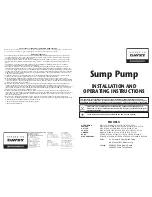
en
Maintenance and repair
22
WILO SE 2019-02
ƒ
Collect operating fluids in suitable tanks and dispose of prop-
erly.
ƒ
Dispose of protective clothing used in accordance with regu-
lations.
ƒ
Use only original parts of the manufacturer. Use of parts other
than the original parts releases the manufacturer from any li-
ability.
ƒ
Collect any leakage of fluid and operating fluid immediately
and dispose of it according to the locally applicable guidelines.
ƒ
Provide the tools required.
ƒ
If flammable solvents and cleaning agents are used, open
flames, naked lights and smoking are prohibited.
9.3
Operating fluid
9.3.1
Oil types
Medicinal white oil is filled into the sealing chamber ex-factory.
The following oil types are recommended when changing the oil:
ƒ
Aral Autin PL*
ƒ
Shell ONDINA 919
ƒ
Esso MARCOL 52* or 82*
ƒ
BP WHITEMORE WOM 14*
ƒ
Texaco Pharmaceutical 30* or 40*
All oil types marked with “*” are approved for use with foods in
accordance with “USDA-H1”.
9.3.2
Filling quantities
The filling quantity is 900 ml (30 US.fl.oz).
9.4
Maintenance intervals
To ensure reliable operation, maintenance tasks must be carried
out regularly. Depending on the real ambient temperatures,
maintenance intervals different from those mentioned in the
contract can be defined! If strong vibrations occur during opera-
tion, the pump and the installation must be checked regardless of
the defined maintenance intervals.
9.4.1
Maintenance intervals for normal conditions
2 years
ƒ
Visual inspection of the power supply cable
ƒ
Visual inspection of accessories
ƒ
Visual inspection of the housing for wear
ƒ
Function test of monitoring devices
ƒ
Oil change
NOTICE! If sealing chamber control is installed, the oil is
changed according to the indicator!
10 years or 5000 operating hours
ƒ
General overhaul
9.4.2
Maintenance intervals for use in sewage lifting units
When the pump is used in sewage lifting units inside buildings or
on plots of land, carry out maintenance intervals and measures in
accordance with
DIN EN 12056‑4
!
9.4.3
Maintenance intervals for harsh conditions
Under harsh operating conditions, specified maintenance inter-
vals must be shortened if required. Harsh operating conditions
include:
ƒ
Fluids with long-fibre components
ƒ
Turbulent inlet (e.g. due to air intake, cavitation)
ƒ
Strongly corroding or abrasive fluids
ƒ
Heavily gas generating fluids
ƒ
Operation at an unfavourable duty point
ƒ
Pressure surges
When using pumps under hard conditions, it is recommended to
sign a maintenance contract. Contact customer service.
9.5
Maintenance measures
WARNING
Attached macerator: sharp edges on the cut-
ting plate and rotating blade!
The macerator can cause amputation of limbs! Wear
safety gloves to protect against cuts and never reach
into the macerator!
WARNING
Hand, foot or eye injuries due to the absence
of protective equipment!
Danger of (serious) injuries during work. Wear the
following protective equipment:
• Safety gloves for protection against cuts
• Safety shoes
• Closed safety goggles
The following pre-requisites must be fulfilled prior to starting
maintenance measures:
ƒ
Pump cooled down to the ambient temperature.
ƒ
Pump cleaned thoroughly and disinfected (if required).
9.5.1
Recommended maintenance measures
Regular inspection of power consumption and the operating
voltage in all three phases is recommended for smooth operation.
In normal operation, these values remain constant. Slight fluctu-
ations depend on the characteristics of the fluid. Power con-
sumption can provide an early indication of damage or malfunc-
tions in the impeller, bearings or motor, which can be rectified.
Larger voltage fluctuations strain the motor winding and can
cause the pump to break down. Regular inspections can therefore











































